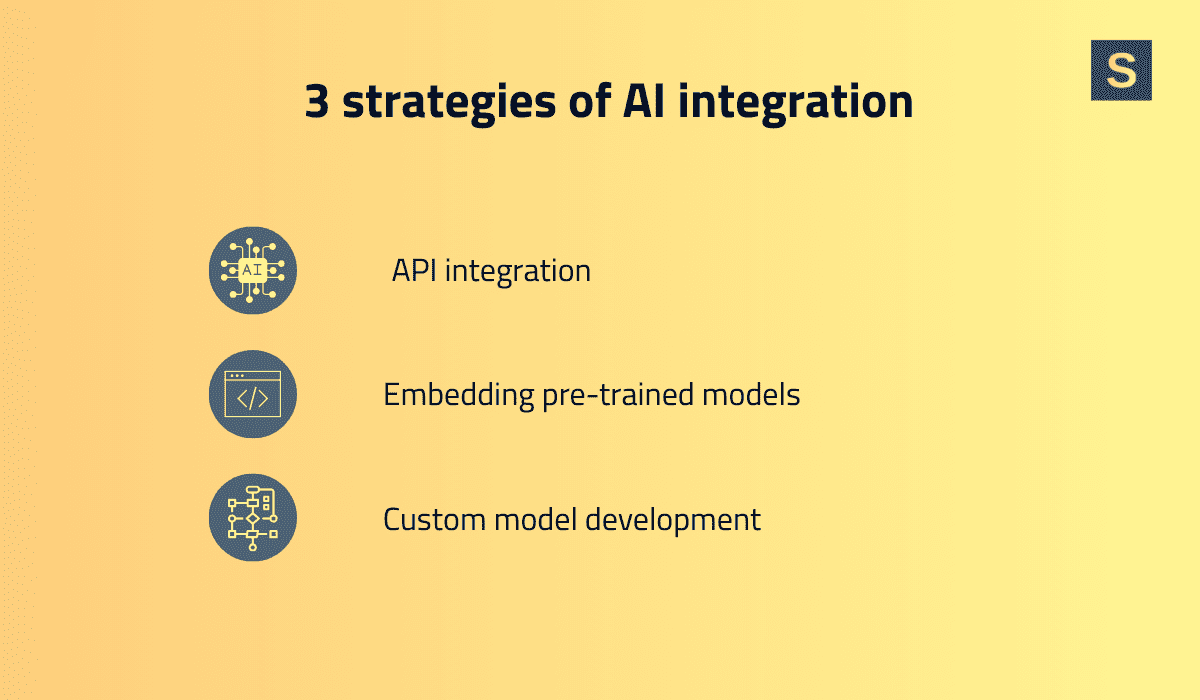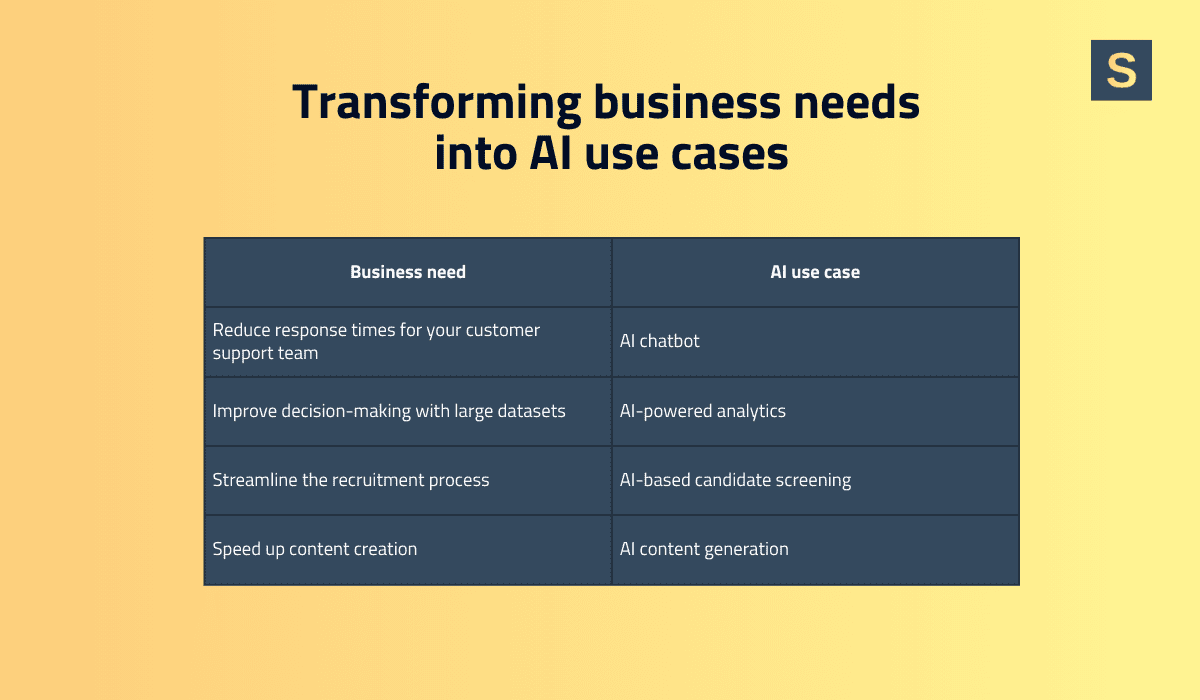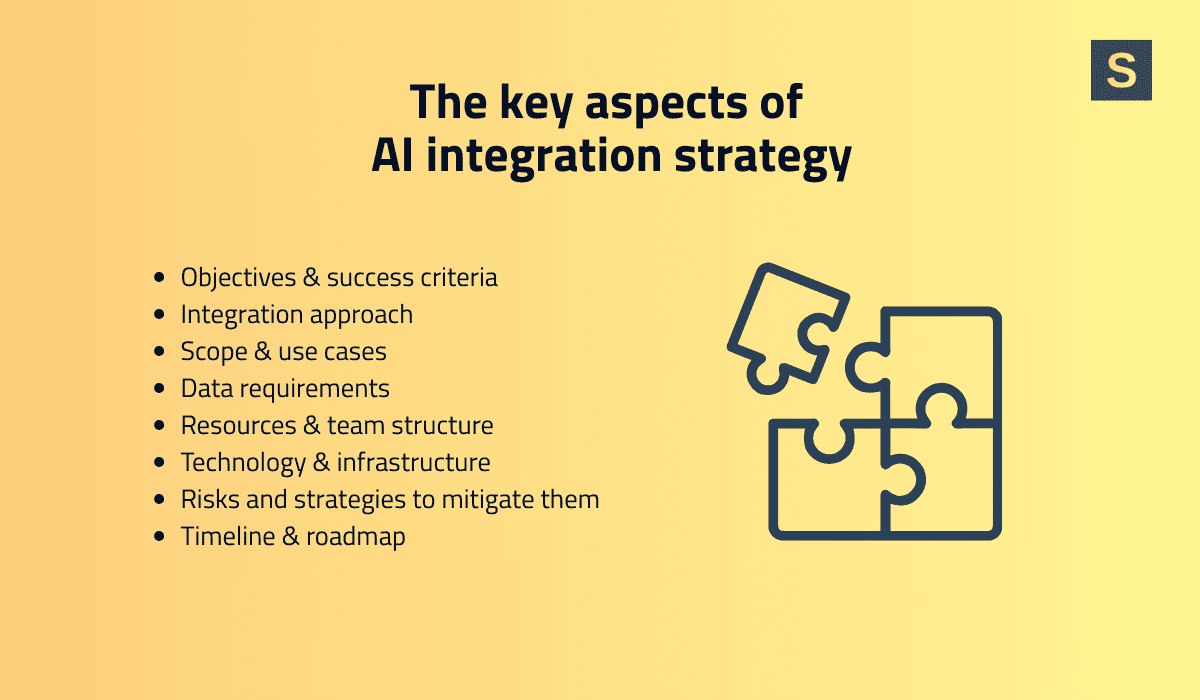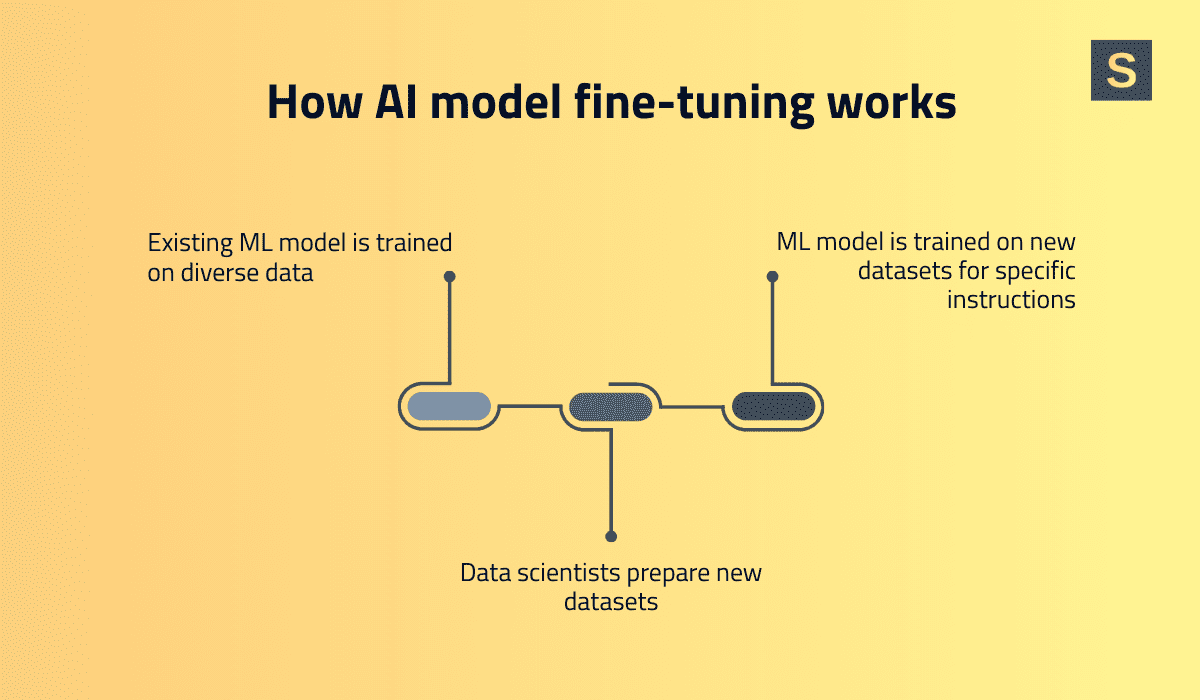Just a few years ago, offering a cloud-based solution was innovative enough to stand out in the market. Today, it’s the baseline. The rapid pace of AI development has inevitably changed how users interact with digital products and what they expect from that interaction:
- Intelligent features instead of static interfaces.
- Engaging conversations instead of one-way touchpoints.
- Smart automation instead of manual effort.
This has become a real challenge for SaaS founders who strive to deliver more value without overcomplicating their products. The good news is, there are plenty of affordable ways to bring AI into your app.
In this article, we’ll discuss the key strategies, processes, challenges, and best practices for AI integration, backed by real-world projects from Seedium’s portfolio.
What is AI integration in practice?
AI integration means adding AI capabilities to existing systems and workflows to unlock new value for users. In tech terms, AI integration is the process of connecting machine learning models, natural language processing, or other AI services to the architecture of your SaaS product so they actively support business logic and user workflows.
Benefits of integrating AI into SaaS:
Adding AI to an existing product often improves its functionality when it aligns with a company's business goals. Possible benefits of such integration include the following:
- Automating repetitive tasks: Helps reduce human errors and frees teams to focus on strategic work. For example, Generali, a global insurance company, implemented AI to process thousands of claims faster. This helped the company reduce manual data entry by over 80% and significantly cut operational costs.
- Smarter personalization: Makes the app feel more intuitive and helps users achieve results faster. For example, HubSpot uses AI to analyze CRM data and recommend the next best action for sales reps.
- Data-driven decision-making: Allows business leaders to pivot quickly based on real insights. For example, Airbnb uses an AI-driven dynamic pricing model to suggest optimal nightly rates for hosts by analyzing demand, seasonality, local events, and historical booking patterns.
- Supporting scalability: Helps to scale operations through smart automation as the user base grows. For example, Shopify reported that its AI-powered support automation helped it scale support globally without linearly increasing headcount.
- Continuous innovation: AI enables features like predictive analytics, anomaly detection, and workflow automation that wouldn’t exist otherwise.
Read also: AI in SaaS: Use Cases and Best Practices
How to Integrate AI into Your Business: 3 Key Strategies
When building SaaS applications from scratch, you can design the architecture with AI capabilities in mind from day one. However, adding AI features to an existing product later requires rethinking and often restructuring parts of your current infrastructure.
Based on the tech implementation, there are three strategies for integrating AI into existing business systems.

Strategy 1: API integration
Using APIs is the simplest way to add AI functionality to your application. You don’t need to train or maintain models yourself. Instead, your SaaS calls an external AI service via an API to perform the tasks you need.
AI API integration is a good choice for simple use cases such as automated text summarization, language translation, or basic chatbots, where you want to add AI as an additional feature rather than core functionality.
This strategy is fast, but it relies heavily on an external provider. Third-party APIs might not perfectly match your specific workflows or data types. Also, using an external API usually means sending your users’ data over the Internet to the provider’s servers. For financial or healthcare companies, this can raise privacy and compliance issues.
Integrating pre-trained AI models can be cost-effective since you don’t need to develop custom solutions. But it’s crucial to understand that each model and platform has its own integration requirements and pricing structures.
For example, GPT-4 charges for input and output tokens. Therefore, understanding your application's token usage is essential for accurate budgeting. For example, if your app generates a significant amount of text per interaction, the costs can accumulate quickly. So, it’s important to optimize token usage to manage expenses effectively.
Read also: HIPAA-Compliant App Development Guide
Strategy 2: Embedding pre-trained models
In this approach, you take pre-trained AI models and embed them directly into your system without relying on external services. Embedding ready-to-use models offers more control and faster response times compared to API calls. You can also fine-tune them slightly using your own datasets for more precise results.
Still, pre-trained models may not perfectly match your specific business needs. Also, they require significant storage and computing resources to operate efficiently.
Embedding pre-trained models is a good idea when you want to add AI capabilities without starting from scratch, but still need more control than the API provides. When you need the AI to work in your product environment, pre-trained models give more flexibility than APIs while saving the effort of full custom development.
Strategy 3: Custom model development
This approach allows you to develop AI models specifically for your SaaS product. This gives you the most agility and accuracy because the model is tailored to your business needs.
On the other hand, custom AI development requires more time, deep AI expertise, and resources, with maintenance and retraining being ongoing responsibilities. Companies usually choose this path when they want to build their own AI-powered SaaS products as a new revenue stream or when they face complex use cases that no suitable pre-trained models can handle.
Hybrid approach
Finally, you can opt for a hybrid approach combining pre-trained solutions with custom AI development for more sophisticated solutions. This helps you balance speed, cost, and customization. For example, companies new to AI can start with APIs or pre-trained models, then gradually introduce custom models as they gather data and understand their needs.
7 Steps to Add AI Features to the Existing App
Let’s delve into the key steps of the AI development pipeline. Please note that the actual process of integrating AI technology will look different depending on the chosen approach and the specific use case.
1. Define an AI use case that meets your business needs
Amidst the hype surrounding Artificial Intelligence, many business leaders forget that AI is just a technology that works effectively when it solves specific business problems. The primary rule for the successful implementation of AI in business is setting realistic goals and expectations.
To do this right, you need to start with a clear goal of integrating AI into your business and measurable results you want to achieve. Understanding this, you’ll be able to define the right AI use case to implement.

AI integration should be directly tied to the needs of your users or business back office. If it’s added just for the sake of having AI, it usually leads to unused features or unnecessary complexity.
2. Choose an AI integration approach and build the strategy
Once you know what you want to achieve, you can proceed to evaluate the best ways to accomplish it. It’s all about choosing the right integration approach and building a strategy. Here, you should connect business goals, tech approach, resources, and risks into a single, actionable plan. A well-defined strategy ensures that AI is not just “bolted on” but woven into workflows and aligned with business goals.

At the same time, you should understand that AI projects involve a lot of uncertainty and require flexibility. The technology is constantly evolving, and you need to be ready to pivot. Building in room for experimentation and iteration will help you adapt quickly and avoid locking yourself into an approach that may become obsolete.
3. Choose the right tools
The next step is selecting the tools, platforms, and frameworks that will bring it to life. The right choice of tools ensures smoother development, easier scaling, and better alignment with your technical and business needs.
You should start by evaluating AI frameworks and libraries such as TensorFlow, PyTorch, Scikit-learn, or Hugging Face, depending on your model requirements. You also need to select the appropriate infrastructure and cloud providers, like AWS, Azure, or Google Cloud, while considering scalability, cost, security, and compliance.
Choosing the right data tools for collection, storage, and processing, including databases, data lakes, and ETL pipelines, as well as services for data cleaning and labeling, is also crucial. Additionally, we recommend incorporating monitoring and MLOps solutions for deployment, version control, performance tracking, and model retraining.
4. Collect and prepare data
You need enough high-quality data for the AI to deliver accurate and reliable results, even if you plan to fine-tune existing models. When it comes to data collection, quality matters more than quantity.
Different industries and business models use different tools to collect data. Online businesses that want to improve personalization, for example, can use analytics tools like Mixpanel, Hotjar, or Google Analytics. Healthcare organizations, on the other hand, have large amounts of data in their electronic health records (EHR) systems, lab reports, imaging systems, and patient monitoring devices. Data scientists can also use datasets from open sources if this works for the project goals.
But collecting data is just a first step. You need to prepare it for AI models. During preparation, data scientists transform raw information into structured formats suitable for analysis, ensuring it is accurate and consistent. This involves:
- standardizing formats;
- cleaning and deduplicating data;
- anonymizing sensitive information;
- sampling data appropriately for efficient processing.
5. Fine-tune models (optional)
If you went the route of using pre-trained models, you may need to fine-tune them with your data. This helps the model adapt to your specific use case and improves accuracy for your unique dataset.

The fine-tuning process requires a sufficient amount of high-quality, relevant data, along with careful preprocessing to ensure consistency. It also involves setting appropriate training parameters, monitoring performance, and iterating to avoid overfitting or bias.
In addition, fine-tuning can be computationally intensive. It requires access to powerful hardware, such as GPUs or cloud-based AI platforms, to efficiently handle training. Collaboration with data scientists and AI specialists is essential at this stage to achieve the best results.
6. Integrate, test, and iterate
The best way to integrate AI into your business system is to start with a simplified version of your AI functionality. Essentially, this should be an MVP that allows you to test the features and gather real user feedback.
By launching an MVP, you can validate assumptions, identify potential issues, and understand how the AI performs in real-world conditions without committing significant time or resources. This iterative approach also enables you to refine the model, improve data quality, and adjust the feature based on actual usage before scaling it across your system.
7. Deploy and optimize
At this stage, we ensure that the model works reliably in a live environment, scales with demand, and integrates smoothly with existing workflows and systems.
You need to remember that AI integration is truly an ongoing process. You need to constantly monitor and optimize after deployment. It includes monitoring the model’s performance, tracking key metrics, and collecting feedback from users to identify areas for improvement.
AI models can degrade over time due to changes in data patterns, so continuous retraining, updating, and refining of the model are essential. This stage also involves ensuring efficiency in computing resources, maintaining data quality, and adjusting algorithms to achieve better accuracy, faster response times, or reduced costs.
Read also: AI Agent vs AI Chatbot: What to Choose for Your Business
How to Integrate AI in the App Development Process
More and more businesses are interested in using AI not to add a feature for users, but to automate the app development process behind the scenes. In our experience, AI-augmented development can greatly accelerate software delivery and improve product quality.
For example, tools like GitHub Copilot can analyze your codebase in real time and offer improvement suggestions. This type of automated support during development reduces the need for manual code reviews and helps prevent technical debt.
The key thing is to understand that AI is not a magic bullet by default. You still need experienced engineers who understand all the whys behind the project and are well-versed in tech to set up the right AI automation pipeline.
The process of integrating AI into the SaaS development process involves the following steps:
- Identify opportunities: Identify areas of your development workflow where AI can add value and automate tasks without introducing significant risk.
- Select the right AI tools: Choose between APIs, pre-trained models, or custom solutions based on your needs, budget, and technical capacity, rather than hype.
- Embed AI into workflows: Integrate AI into development pipelines, code editors, or testing frameworks so it can assist developers in real time. Adapt AI models to your specific codebase, datasets, or business rules to improve accuracy and relevance.
- Monitor: Continuously track AI performance and make adjustments to ensure the AI provides meaningful support.
- Optimize and scale: As the team grows or the codebase expands, ensure the AI continues to perform efficiently and supports evolving development needs
If you’re not sure what tools to choose and how to set up the AI-augmented development process, feel free to reach out for consultation.
Read also: AI Coding Assistants Comparison: Best AI Tools for Coding
AI Implementation Checklist for SaaS
Integrating AI into a product is a complex process that demands careful planning and advanced technical expertise. It’s easy for teams to overlook critical aspects that aren’t immediately obvious. That’s why we’ve created a 24-point checklist to make your AI implementation process more efficient and effective. Feel free to download it for free here.

Success Stories of AI Integration
The complexity of AI integration largely depends on the role the intelligent functionality will play in your product, whether it will be a core or supporting function. Let me illustrate both possible implementation options with real projects from the Seedium portfolio.
Integrating AI into a SaaS application
Project description: Cultcha is an HR cultural intelligence platform that helps organizations build a strong workplace culture. The client contacted us to rebuild the software to address scalability issues and improve user flows.
AI integration: Since the platform focuses heavily on data analytics, we needed a feature that could condense large volumes of information into an executive summary. To achieve this, we built an AI-powered assistant that generates a structured summary highlighting the candidate’s strengths and weaknesses, the match with the company, and specific points that require attention.
This feature was designed to support quick decision-making by team leads and C-level specialists, who could review the summary before turning to a detailed report.
The task was straightforward to address through integration with third-party AI services, and we chose to implement it using OpenAI. As a result, the integration enabled us to launch the new functionality quickly, allowing the client to deliver value to users much sooner.
Read the full case study here.
Developing an AI-powered resume builder
Project description: AI Ignition is an AI-powered resume builder that helps job seekers create ATS-friendly resumes, increasing their chances of a successful hire. The client engaged Seedium engineers to support the development and integration process.
AI integration: Since AI is part of the product’s core functionality, the client’s team used more sophisticated algorithms and integration solutions to empower job seekers with AI-driven insights. This required more computing resources and a scalable architecture, both on the back-end and front-end.
Our engineers designed a robust, scalable architecture that adapts to growing business needs and future user demands. Working in close collaboration with the client’s back-end team, we implemented seamless integrations with internal services and third-party APIs, ensuring a smooth and consistent user experience.
Read the full case study here.
Challenges and Best Practices for Integrating AI into Your Business
Now, let’s move on to the best practices for integrating AI into SaaS based on our experience. The first one is very simple: you should never start an AI project without understanding the potential challenges. This will help you plan additional strategies to overcome possible problems.
1. Data quality and availability
Many companies struggle with fragmented data sources, missing values, or poor labeling. Without proper data cleaning and preparation, the model’s performance will suffer.
Best practices to overcome this challenge:
- Centralize data collection in one place (data lake or warehouse).
- Clean, standardize, and anonymize data before training.
- Start with existing public datasets to fill gaps, then gradually build your own proprietary dataset.
- Continuously monitor data quality and set rules for validation.
2. Security and compliance
SaaS products often deal with sensitive user data. AI integration increases the risk of breaches and requires compliance with strict regulations (GDPR, HIPAA, etc.). Mishandling data can damage trust and lead to legal issues.
Best practices to overcome this challenge:
- Encrypt data both in transit and at rest.
- Anonymize and minimize sensitive data used for training.
- Choose cloud providers and AI platforms that are compliant with relevant standards.
- Build compliance checks into the development lifecycle rather than adding them later.
3. User experience
Despite the high demand for AI, some users may be skeptical of AI features, especially if they feel intrusive or inaccurate. A poorly designed AI integration can frustrate users rather than help them.
Best practices to overcome this challenge:
- Start with an MVP and test with real users before scaling.
- Keep AI outputs explainable: show why a recommendation or prediction was made.
- Provide users with control to disable AI features.
- Collect user feedback continuously and refine the feature iteratively.
4. Performance
AI models may work well in testing but struggle in production, especially with large workloads. Latency, model drift, and declining accuracy are common risks.
Best practices to overcome this challenge:
- Monitor model performance continuously with metrics such as accuracy, latency, and error rates.
- Retrain models periodically with fresh data to prevent drift.
- Optimize queries and use caching for frequently requested results.
- Balance accuracy and speed. Sometimes a simpler, faster model is better for real-time SaaS use cases.
5. Scalability
As the number of users and data grows, the AI infrastructure must scale. Without proper planning, costs can skyrocket and performance can drop.
Best practices to overcome this challenge:
- Use cloud-based AI services that can scale automatically.
- Adopt containerization for flexible deployment (e.g., Docker, Kubernetes).
- Implement load balancing to distribute workloads effectively.
- Regularly review token usage and optimize prompts or requests to control costs when using third-party APIs.
Read also: How to Build Scalable Multi-Tenant SaaS Architectures: Tech Leader’s Guide
Build and Scale with Seedium
If you’re thinking of integrating AI into your application or need development assistance, feel free to contact us to see how we can meet your needs. With over 200 successfully released products over the past eight years, we are well-equipped to build and scale software solutions of any complexity.
Feel free to check our SaaS app development services and AI integration services or send us a message using the form below.





